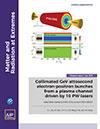| 投稿方式:官网投稿 |
- 栏目频次
- 单位占比
-
热词

中频栏目
低频栏目
-
更多
期刊简介
- 《极端条件下的物质与辐射(英文)》(MatterandRadiationatExtremes)(双月刊)由中国工程物理研究院科技信息中心主办。本刊涵盖的领域包括基础物理在极端:原子物理学,核物理学和极端等离子体物理学、辐射和高能粒子生成、创新的加速器;激光和粒子束融合:激光和粒子束融合物理、实验和诊断、目标制造、激光和光学,激光设备,保护和废物处理技术;磁驱动融合:磁惯性融合、Z捏,磁化目标融合、其他融合方法;脉冲功率技术和大功率电磁学:脉冲电源技术,电磁环境效应、大功率微波/毫米波/太赫兹技术、大功率电磁脉冲保护技术、相关数值模拟和计算技术;高压物理与材料科学:高压物理学研究的方法和技术极端条件下的、物质性质和状态方程、高压材料科学。
-
基本信息
- 期刊名称:极端条件下的物质与辐射(英文)(Matter and Radiation at Extremes)
- 主管单位:中国工程物理研究院
- 主办单位:中国工程物理研究院科技信息中心
- 国内刊号:CN 51-1768/04
- 国际刊号:ISSN 2468-2047;EISSN2468-080X
-
- 出刊日期:
- 期刊定价:
-
- 邮发代码:
-
- 所在省区:四川
- 邮政编码:
- 联系地址:
-
投稿信息
-
- 学科分类:物理
- 版面费用:待核实
-
- 字数要求:6000-32000
- 查重要求:-
-
- 复合因子:1.086
- 综合因子:0.924
-
- 审 稿 费:待核实
- 稿费:待核实
- 本刊可发:
- 特殊属性:外文期刊,第二批认定学术期刊
-
联系方式
- 投稿网址:https://mre.peerx-press.org/cgi-bin/main.plex
- 官网网址:https://pubs.aip.org/aip/mre
- 电话传真:0816-2483833
- 电子邮箱:mre-edoffice@aip.org(官网邮箱)
- 微信公众号:

